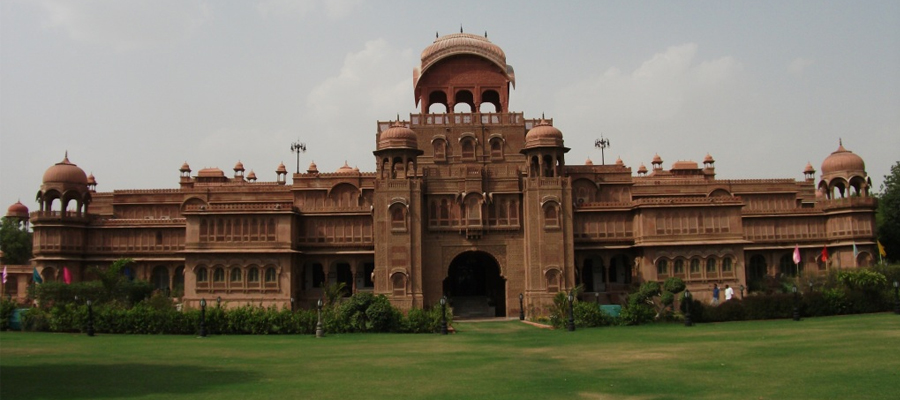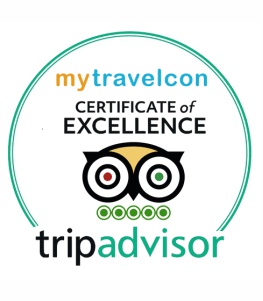
Overview
An oasis situated in the middle of the quaint Thar (desert) - Places to Visit in Bikaner Rajasthan predominantly draws tourists from all over the world for its exciting desert safari scene and the imposing Junagarh Fort. However, there is much more to the benign Bikaner than meets the eye.
Introducing Bikaner
Heritage Places / Sightseeing in Bikaner
- Junagarh Fort
Among the places to visit in Bikaner, Junagarh Fort unarguably leads the rest of the heritage sites thanks to its majestic dimensions and exquisite art and architecture. Originally constructed by 1593, the fort witnessed elaborate additions by the dozens by the subsequent heirs of the founder Maharaja Raja Rai Singh, the latest addition made in 1943 only. Per se, the fabulous fort boasts of as many as thirty-seven (37) unique palaces, temples and pavilions across the complex.
What puts the Junagarh Fort apart from any other fort in Rajasthan is its unusual location on ground level (instead of some hill top) and its proven track record of remaining invincible throughout its lifetime in use. The fort also happens to be the most well-preserved and well-maintained forts in the state.
- Laxmi Niwas Palace
Bikaner sightseeing cannot be complete without a tour of the former royal residence - the Laxmi Niwas Palace. One of the most impressive modern palaces in India designed in Indo-Saracenic style; it was commissioned by the British-controlled regency in 1896 to extend a suitable modern residence to the then minor (by age) Maharajah Ganga Singh. By 1902, the construction of the palace came to a close and the palace gathered generous accolades from its guests for its sumptuous architecture, well-balanced proportions, harmonious presence with surroundings and widespread use of finest quality intricately carved red sandstone.
Now a prominent heritage hotel in Rajasthan, staying at Laxmi Niwas Palace not only extends a very comfortable base to tourists to explore Bikaner, but also offers a genuine simulation of royal life from bygone era.
- Lalgarh Palace
As soon as the construction of Laxmi Niwas Palace was accomplished in 1902, its British architect Sir Samuel Swinton Jacob drew up fresh plans to extend the palace into a larger Lalgarh palace.
Arranged around two huge courtyards, Lalgarh Palace is the entire complex that came into being after the planned additions to the Laxmi Niwas Palace. While the most stunning wing in the complex remains Laxmi Niwas Palace, the other wings around are nevertheless impressive with magnificent pillars, intricate filigree and latticework, Italian colonnades and elaborate fireplaces. One of the wings is the private residence of the royal family of Bikaner. The west wing is Shri Sadul Museum where a host of candid family photographs, clothes, accessories and other memorabilia belonging to the royal family are on display. The Lalgarh Palace is now a celebrated heritage hotel that welcomes guests to lavish halls, lounges and pavilions, including a sprawling dining room that can seat 400 diners at a time.
- Karni Mata Temple
Easily the most incredible of places to visit in Bikaner – Karni Mata Temple is an isolated but ornate small white marble Hindu temple sacred to “Karni Mata” - a mystic matriarch from the 14th-15th centuries. The temple is globally celebrated as the Rat Temple being home to over 20,000 brown rats and a handful of white rats that are affectionately called as “Kabas” (little children) in vernacular. Local pilgrims behold the rats holy, as such feed and protect them extensively. It is considered a supreme blessing to have food or water sampled by the rats. In fact, devotees heartily encourage the rats to scamper over their feet and nibble in their platter. Spotting a white rat is held especially auspicious and believed to shower life-long good luck and spiritual progress.
The Karni Mata Temple is located 30 km from Bikaner in a small desert town called Deshnoke.
- Bhandeswari Jain Temple
The 15th century Bhandeswari Jain temple is one of the key Bikaner tourist places and the oldest landmark in the city. The three-storied shrine draws tourists from around the world to look at delicate gold leaf paintings, Usta art and extensive mirror work across its interiors. By virtue of its location in the thick of Bikaner, the cityscape from the top floor of the temple is also a charm among visitors.
- Jain Havelis
A typical Bikaner sightseeing itinerary definitely includes a trip to age-old Havelis in the city that bear testimonies to high-quality workmanship that existed in the past centuries. A walk through the Gogagate, Daddhon Ka Chowk, Rangari Chowk, Assanion Ka Chowk, Mohta Chowk, Binnanion Ka Chowk, Daga Chowk, BK School and Jassuar Gate track is frequently undertaken by tourists to survey the intricately carved lavish mansions with extensive mirror work, delicate gold leaf paintings and fabulous frescoes.
- Camel Breeding Farm
ICAR-National Research Centre on Camels is one of the important Bikaner tourist places. Just 8 km away from Bikaner, the center extends an optional guided educational tour of the farm to visitors from 02:00 PM to 06:30 PM. A camel milk parlor inside the farm vends camel milk as well as other hot and cold beverages made of camel milk. The center is basically engaged in cross-breeding camels from Bikaner, Gujarat and Jaisalmer to develop the best quality camels for Border Security Forces (BSF), and sell the rest to the villagers at large.
- Gajner Wildlife Sanctuary and Gajner Palace
Once a royal hunting ground, Gajner Wildlife Sanctuary is now a privately-owned scenic forest reserve by the lakeside. Home to several exotic birds as well as wild animals like blackbucks, gazelles, nilgai, desert foxes and wild boars, the sanctuary is ideal for those looking for a hedonistic getaway from the city blues.
Gajner Palace, now a heritage hotel, is situated adjacent to the sanctuary and offers a perfect base to the visitors for a luxurious stay. Vehicles for tour of the sanctuary have to be booked from the palace only. Both guests and non-guests can hire vehicle from the palace for an absorbing tour of the sanctuary.
- DeviKund Sagar
About 8 km east from Bikaner city lays DeviKund Sagar, dotted with elegant cenotaphs belonging to the royal family of Bikaner. Known as “Chattris” in regional dialect, the structures are famous for their fine frescoes and intricate friezes on white marble and red sandstone. The place is also a must-visit for those keen on spending some quiet time amid architectural exuberance, away from the city’s hustle-bustle.
- Festivals and Events in Bikaner
Renowned for cultural riches and riots of colors, Bikaner celebrates a host of local festivals including Kolyat, Gangaur, and Holi. The camel festival held here in January every year is a time-honored tradition that promises thrilling time to spectators. The event begins with a lively procession of festooned camels and carries on over days with several camel–related competitions taking place including camel races, camel milking contests, and acrobatics by camels.
- Shopping in Bikaner
Shopping at 'Abhivyakti' outside Junagarh Fort is highly recommended as it is one of a kind shop (run by Urmul Trust) that sells handicrafts from 70 neighboring villages, including like embroidered slip-on shoes, camel wool carpets, lacquer covered woodwork, ethnic furniture, woollen and cotton handlooms among other souvenirs. The shop is doing a sterling job at promoting, uplifting and empowering the rural communities, with the support and encouragement of the royal family of Bikaner.
How to reach Bikaner
By AirThe nearest airport to Bikaner is about 07-hour drive (253 km) away at Jodhpur. Plenty of tourist buses, state roadway buses, and private vehicles ply regularly between Jodhpur and Bikaner outside the airport.
By RailBikaner Railway Station connects Bikaner to the rest of India through a reliable network of fast and mail trains.
By RoadA sophisticated web of national and state highways connects Bikaner with all the major cities of India by road. Rajasthan State Roadways, as well as Private buses, ply regularly to and from all parts of Rajasthan as well as neighboring states of Haryana, Delhi, and Punjab. Not to mention, private vehicles like jeeps and cars are easily available on hire from Jodhpur, Jaipur, and Delhi to travel to Bikaner.
What is the best time to visit Bikaner?
Weather in Bikaner is at its pleasant best from October to March during the winter season. Visiting the city in January is particularly recommended as the period coincides with the annual Camel festival and fair in Bikaner.
Being a desert town, Bikaner witnesses oppressively hot summer season from March to June. The maximum temperature tends to touch up to 42 degrees Celsius that can cause heat stroke.
From July to November, moderate downpour keeps Bikaner humid and may not come across befitting for sightseeing.

